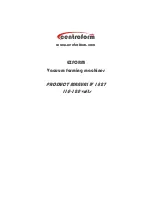
408-2349
2
of 5
Rev
E
Figure 2
3. Close the handles part way by pulling the short
handle, then grasp the tool handles and completely
close the handles until the ratchet releases. See
Figure 4.
4. Allow handles to open FULLY, then remove the
crimp end. Inspect the crimp end to ensure a
properly crimped assembly.
Figure 3
Figure 4
Damaged product should not be used. If damaged
product is evidnet, it should be replaced.
4. MAINTENANCE AND INSPECTION
It is recommended that a maintenance and inspection
program be performed periodically to ensure
dependable and uniform terminations. Though
recommendations call for at least one inspection a
month, frequency of inspection depends on:
1. The care, amount of use, and handling of the
hand tool.
2. The presence of abnormal amounts of dust and
dirt.
3. The degree of operator skill.
4. Your own established standards.
The hand tool is inspected before being shipped;
however, it is recommended that the tool be inspected
immediately upon arrival to ensure that the tool has
not been damaged during shipment.
4.1. Daily Maintenance
1. The hand tool should be immersed (handles
partially closed) in a reliable commercial degreasing
compound to remove accumulated dirt, grease, and
foreign matter. When degreasing compound is not
available, tool may be wiped clean with a soft, lint-
free cloth. Do NOT use hard or abrasive objects that
could damage the tool.
2. Make certain that the retaining pins are in place
and that they are secured with retaining rings.
3. All pins, pivot points, and bearing surfaces should
be protected with a THIN coat of any good SAE 20
motor oil. Do NOT oil excessively.
Rotate Tool
Head 180°
Retaining
Rings
Crimping Connector
Shoulder of Crimp
End Resting Against
Crimping Die
Center Contact
Bottomed in Center
Contact Section
Ferrule Resting
Firmly on Insulation
and Braid Sections
Cable
Front of
Tool
Short Handle
on Ratchet
CAUTION
!























